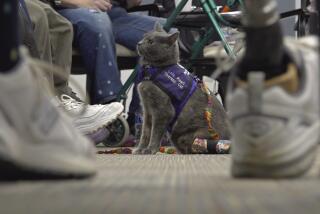The value of a visit by an animal
- Share via
“A small pet animal is often an excellent companion for the sick,” wrote Florence Nightingale in 1859, but it was not until a century later that scientists began documenting that claim.
Clinical psychologist Boris Levinson of New York’s Yeshiva University wrote about pet-oriented child psychotherapy in the 1950s after finding that disturbed and withdrawn children opened up to him when his dog, Jingles, was in the room. Since the 1980s, researchers have documented the benefits that canine visitors bring to children and adults with depression, autism, hyperactivity disorders, heart failure and Alzheimer’s disease.
In what experts in the field call “animal-assisted therapy,” a pet owner works with a professional therapist to help a patient meet specific goals such as stretching, walking and so on. “Animal-assisted activities” are more casual visits to nursing homes or hospitals, where patients pet or hug the animals or watch them perform tricks.
Dogs, including mixed breeds and rescues, are the most commonly used pets. They must be well-behaved, know basic commands, really like people and have a gentle temperament.
Several nonprofit groups train dogs and organize visits.
One of the oldest is the Seattle-based Delta Society (www.deltasociety.org). Delta-licensed instructors train and register pet-partner teams throughout the country; the website lists contacts for each state. A Los Angeles-based group, Love on 4 Paws (www.loveon4paws.org), has about 80 volunteer-pet teams who visit special education classrooms, nursing homes, Childrens Hospital Los Angeles and Shriners Hospitals for Children, Los Angeles.
More to Read
Sign up for Essential California
The most important California stories and recommendations in your inbox every morning.
You may occasionally receive promotional content from the Los Angeles Times.










